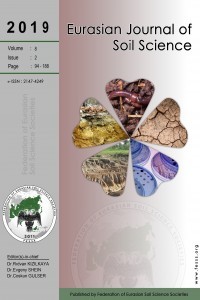
Eurasian Journal of Soil Science
Yazarlar: Marlena YANEVA, Tsveta STANİMİROVA, Rositsa KENDEROVA
Konular:-
DOI:10.18393/ejss.70419
Anahtar Kelimeler:Red soils,Mineralogy,Clay,X-ray diffraction
Özet: The present study aims to compare mineralogical composition of red soils, formed on marbles in South Bulgaria. We used mineralogical analysis of heavy and light mineral fraction in immersion under polarizing microscope and X-ray diffraction analysis of bulk sample and clay fraction. Three test polygons, located in South Bulgaria were examined: Petrovo, Nova Lovcha and Dobrostan, which are characterized with different latitude, altitude, and exposition. Three or more sites from each polygon were sampled and analyzed. The red soils are formed on white and gray calcite and calcite-dolomite marbles, impure silicate-rich marbles and only in one site – on marble breccias. We determined the following mineral phases in red soils: calcite, dolomite, quarts, and feldspars, mica, illite-type mica, illite, smectite, vermiculite-smectite, and kaolinite. Heavy minerals are represented by amphibole, titanite and epidote, and minor amounts of zircon, garnet, tourmaline, rutile, pyroxene, andalusite, kyanite, sillimanite and apatite. Opaque minerals are predominantly goethite and hematite. Plant tissue is abundant in light fraction from the uppermost soil horizons. Analyses of heavy mineral fraction show presence of metamorphic and igneous minerals which indicate participation of weathering products from other rock types in the nearby area. The types of heavy minerals in soils depend more on composition of parent rocks and geomorphic position than on climate type. Soils from Nova Lovcha show similar composition, but the quantity of goethite and hematite significantly increase in soil from plain. Typical high-metamorphic minerals as andalusite, kyanite and sillimanite present only in Nova Lovcha, while garnet dominates in Petrovo and opaque minerals - in Dobrostan. Red soils, formed on slopes, where erosion prevails over accumulation, contain more illite, smectite and vermiculite-smectite, and very few or no kaolinite, whereas the kaolinite is dominant in soils formed on plain. The mineralogical composition of clays in different polygons depends on geomorphic position (altitude, slope or plain), and less on climate type. The weathering processes in the highest polygon Dobrostan (more than 1200 m) are in early stage (illite, vermiculite-smectite, and smectite), whereas in Nova Lovcha (above 700-900 m) and Petrovo (1000 m) the domination of kaolinite suggests an advanced weathering processes.